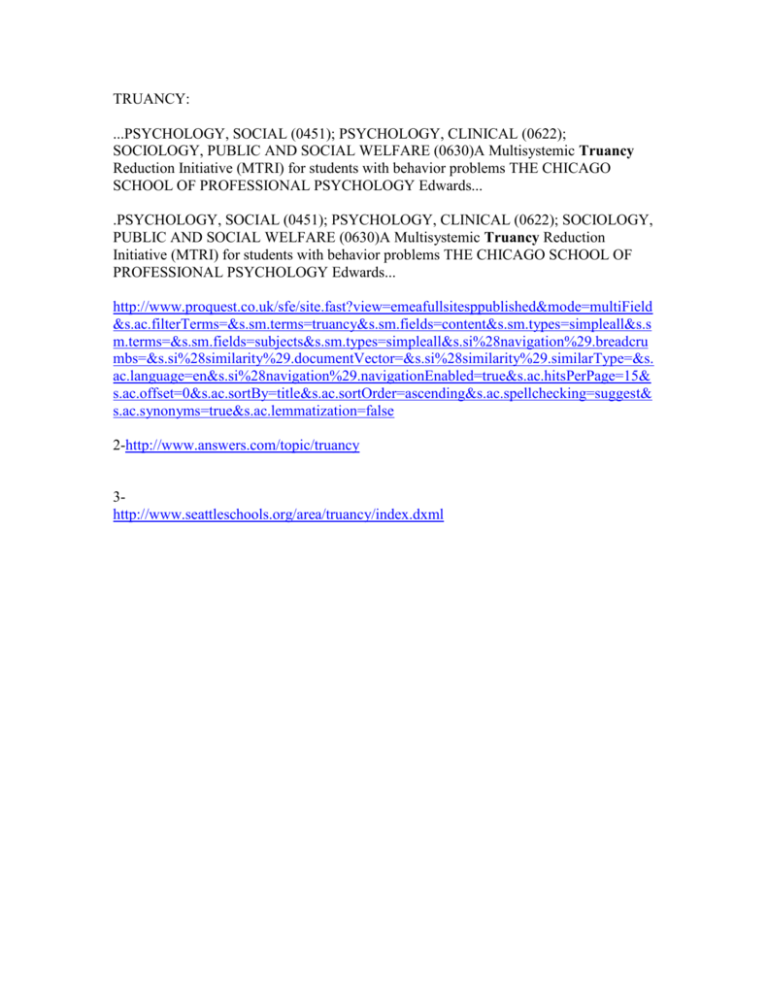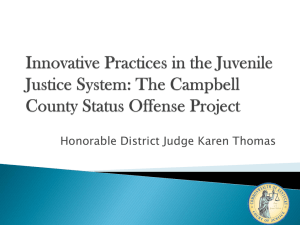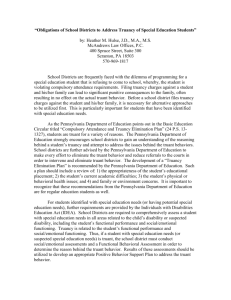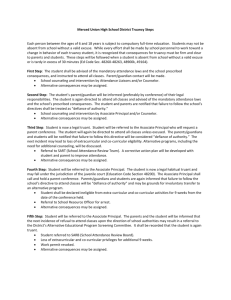
TRUANCY:
...PSYCHOLOGY, SOCIAL (0451); PSYCHOLOGY, CLINICAL (0622);
SOCIOLOGY, PUBLIC AND SOCIAL WELFARE (0630)A Multisystemic Truancy
Reduction Initiative (MTRI) for students with behavior problems THE CHICAGO
SCHOOL OF PROFESSIONAL PSYCHOLOGY Edwards...
.PSYCHOLOGY, SOCIAL (0451); PSYCHOLOGY, CLINICAL (0622); SOCIOLOGY,
PUBLIC AND SOCIAL WELFARE (0630)A Multisystemic Truancy Reduction
Initiative (MTRI) for students with behavior problems THE CHICAGO SCHOOL OF
PROFESSIONAL PSYCHOLOGY Edwards...
http://www.proquest.co.uk/sfe/site.fast?view=emeafullsitesppublished&mode=multiField
&s.ac.filterTerms=&s.sm.terms=truancy&s.sm.fields=content&s.sm.types=simpleall&s.s
m.terms=&s.sm.fields=subjects&s.sm.types=simpleall&s.si%28navigation%29.breadcru
mbs=&s.si%28similarity%29.documentVector=&s.si%28similarity%29.similarType=&s.
ac.language=en&s.si%28navigation%29.navigationEnabled=true&s.ac.hitsPerPage=15&
s.ac.offset=0&s.ac.sortBy=title&s.ac.sortOrder=ascending&s.ac.spellchecking=suggest&
s.ac.synonyms=true&s.ac.lemmatization=false
2-http://www.answers.com/topic/truancy
3http://www.seattleschools.org/area/truancy/index.dxml
4-Truancy
Date: Tuesday, 8 July 2008
Expert:
Tags: Parenting, Schooling, Teenage Issues
You've probably read that some states are beginning a new crackdown on truancy, not so
much to catch the kids out, but to help the kids out and to hopefully catch the families
before the situation deteriorates further.
The reasoning behind the move is that research evidence point clearly and consistently to
a correlation between school truancy and other family problems (eg domestic violence,
drug abuse, depression, child management chaos etc).
It’s a problem that's more common than we’ve been prepared to admit; on average 5.6%
of children (that’s about 50 kids per average high school) have gone AWOL. In the past
politicians have relied on moral pressure on parents to get the kids back to school but too
often this is easier said than done. Now, as this new legislation demonstrates, there's
some real action under way. In many states, schools are issuing pass outs for children
leaving the school grounds. If police catch a student off campus (shopping malls,
cinemas, parks and beaches are the favourite hang-outs), then they can take him/her back
to school and parents will be notified. In some states, three such offences mean that a
formal meeting of police, parents, principal and the child will take place to see what’s
going wrong and what remedial action needs to be put into place.
Now there's the problem. It's all very well having laws in place and teeth to enforce the
law but if the school support services are stretched to the limit already (and they are) then
the rehabilitation won’t happen. For the program to work staffing of counsellor positions
and home-school liaison officer positions must be adequate to follow up the case with the
student, family and teachers. Further more, parents must
be provided with and must attend behaviour management training if they want their child
to re-attend that school.
There can be no doubt that parents play a key role in the attitudes children develop
towards school attendance. Research has found five factors behind poor attendance:
• Family background - poor housing, disinterested parents, criminal activity, broken
homes, parent absence, many siblings etc
• Academic difficulties - special needs not recognised or catered for, language
problems etc
• Relationship problems - personality clash with teacher, bullied, bullying and
unpopular, misfit in class, social difficulties, separation anxiety from parent, precocious
or unable to relate to peers etc
• Behavioural difficulties - reaction to home problems, hyperactivity, school phobia,
anxiety, psychiatric problems, aggressive/stubborn etc
• School based problems - ineffective monitoring, poor welfare system,
poor home/school liaison, lack of relevance of the curriculum, unawareness by staff of
student need etc
Of the 10% away each day it’s estimated that 1-2% are absent for a legitimate reason
other than illness (eg family funeral, family commitment), 3-4% are absent due to illness
which leaves approximately 5% of students still absent. This situation is seen by
education authorities and police as a major problem.
And the excuses for kids'non attendance can be as comical as they can be serious,
especially when it comes to school sickies. Head and tummy ailments are clear
favourites, but some of the more creative ones include being unable to stand, blurred
vision, the recurrence of an ear ache 'only worser', red biro looking spots on the tummy,
and writer's cramp. One child even claimed a premonition of a bomb threat. Parent
explanations are just as comical - "she's got a cartridge in her knee", "he suffers from a
genital bad back", she had to go back to the doctor's for her leg", "she hates going and has
become an electric newt" (elective mute), "his father was home", "couldn't wake the
bugger", "please excuse my child as she was absent".
If your child feels sick before school often or if the recovery rate after 9am is
remarkable, it's worth looking for outside causes such as too many late nights, too much
junk food, or just too much else on. Maybe taking sickies is a family virus or perhaps the
child is failing in the playground or in the classroom. An ounce of prevention is worth a
pound of cure, so try a balanced diet, a balanced life, some time to talk about any
problems and a general drop in home bustle and bristle. If a happier, problem-free home
doesn’t help, then talk to the teacher or counsellor and get some school or remedial help and then keep talking until you are satisfied that help is planned. A day at home is rarely
the cure.
Iemma Government crackdown on truancy
• Under the new measures (designed to ensure children aged six to 16 are attending
school) courts will be able to force parents of children who aren't attending school into
drug rehabilitation, mediation or other forms of counselling. And those who disobey the
court could face a jail sentence.
• The new laws also include allowing independent medical experts to assess if a child is
too sick to be enrolled at school, rather than relying on the advice of parents. The
Department of Education will also be given powers to seek a court order to force a parent
to enrol their child at a recognized school.
• Anyone who informs the education department that a child isn't attending school will
get whistleblower-style protection.
• Mr Iemma says non-government schools will now have to report
unsatisfactory attendance or non-enrolment to the Education Department as well as
public schools.
Sydney high school drops controversial fingerprinting program
• A controversial fingerprinting program at a Ku-ring-gai Creative Arts High s north
has been temporarily dropped amid complaints from parents and civil libertarians after
some families who wanted to exercise their right to opt out of the program were denied
the choice.
• The program involves students having their fingerprints scanned and turned into a
digital code in order to mark their attendance.
• The system (which is not a government initiative) is being used in approximately six
public schools across NSW. These sorts of attendance measuring systems can be used by
schools providing they follow privacy guidelines and parents agree.
Truancy in Victoria
• The Victorian Education and Training Reform Act 2006 provides for the prosecution
of parents who fail to comply with the duty to ensure children of compulsory school age
attend school. The fine for non compliance is 1 penalty unit ($110.12) for each day the
child is not attending. The Act provides provision for reasonable excuses like illness or
unavoidable causes.
• The Victorian Government has an emphasis on raising awareness of the importance of
school attendance through campaigns such as 'It’s Not OK to be Away'.
Queensland
• Police are taking up to 10 children a day back to schools as part of a crackdown on
truancy around Innisfail. Police liaison officers are patrolling the streets of the regional
centre, south of Cairns, daily on the lookout for students who had no reason not to be in
school and they're targeting teenagers who were committing crimes instead of attending
school in Cairns.The officers evaluated each situation, sending students back to school
where appropriate and forwarding their names to schools in other instances.
• Primary and secondary school principals have collaborated with police officers to
develop ways of reducing truancy. The number of truants found had dropped since the
program began.
• A New Family Responsibilities Commission which will operate in Cape
York communities would tackle truancy among other issues. Parents faced fines of up
to $450 for a first offence and $900 for a second offence as a last resort if their children
were regularly absent from school and negotiations failed.
Dr John Irvine
http://9am.ten.com.au/family-teenage-issues-truancy.htm
5-Student Truancy
How big of a problem is this?
Apr 3, 2007 Barbara Pytel
Whether you call it truancy, playing hooky, unexcused absences or skipping school,
students are not showing up for school in massive numbers.
What is Truancy?
According to Webster's dictionary, the word is of "Celtic origin meaning vagabond, idler,
vagrant, one who shirks duty, one who stays out of school without permission." How bad
is the school truancy problem?
Statistics
According to Kid Source On Line, truancy statistics in larger cities are shocking.
New York City--15% gone per day
Los Angeles--10% gone per day
Pittsburgh--12% gone per day
Problems Stemming from Truancy
While truancy in itself is a problem and one of the greatest predictors of dropping out
from school, other issues are also linked to truancy:
Daytime juvenile crime
Drug/alcohol use
Unwanted pregnancies
Depression
Violence
Causes
While there are as many causes of truancy as there are students, a study (ERIC/CEM and
Linn-Benton Education Service District 1992) list the top reasons given by students:
Boredom
Loss of interest
Irrelevant courses
Suspensions
Bad relationships with teachers
How do teachers see the problem?
Ads by Google
Study in Adelaide
Study in Adelaide & Get 5 Bonus Migration Points! Find Out More Now
Studylink.com/Study-in-Adelaide
Summer with Boston Ballet
Residential Summer Dance Program. Age 10-19. International Auditions!
www.bostonballet.org/school
Student problems with family
Student problems with peers
There is obviously a "disconnect" between how students see things and how their
teachers see them.
Steps to Reduce Truancy
Schools are trying to find a successful program to reduce truancy but none seem to be
truly working.
Get tough policy
Alternative schools
Truancy officers
Fining parents
Jailing parents
Loss of welfare benefits
While these may initially sound effective, none seem to work long-term. If school is not
relevant to students, getting tough is not a good incentive.
Maryland
"No School--No Keys" Maryland lawmakers enacted a new, tough law. Students with 10
or more unexcused absences in the previous calendar year will have their licenses
suspended. [Washingtonpost.com, Lisa Rein, March 16, 2007] Schools will be required
to send unexcused absences to the Department of Motor Vehicles. The bill passed by a
133 to 1 vote. This legislation will punish the students and not the parents that could be at
work and unable to make sure the student is in school.
24 other states have linked school performance or attendance to a driver's license.
However, there is concern that if students will be punished for not attending classes, they
may just drop out at 16. No longer in school. No longer truant--I get to drive.
What About Counselors?
If students could have a meaningful relationship with one adult in school, research shows
that attitudes could be improved about school and goals in life. Counselors would seem to
be the first in line. However, counselors are spread very thin. Ratios of counselors to
students can be as high as 700 to 1. If counselors can help enroll the successful students
in colleges, they have no time left. Dropouts give reasons why they gave up on school.
They say no one took the time to do the following:
tell them they were college bound,
give them a college admission timetable,
help them with financial aid options,
show them how to predict the cost of college,
steer them toward the technical college areas
offer options as skilled workers.
Education is no longer relevant to a large percentage of our students. The educational
system is a relic and needs to be overhauled. While that is happening, we need to keep
students in school with more interventions that the students themselves think could work.
Related articles: Florida Career Academies Concept, Boys and School, Single Sex
Classrooms.
Read previous articles on Educational Issues.
Copyright article 2007 Barbara Pytel. All Rights Reserved.
Read more at Suite101: Student Truancy: How big of a problem is this?
http://educationalissues.suite101.com/article.cfm/student_truancy#ixzz0e2i0RY01
http://educationalissues.suite101.com/article.cfm/student_truancy
6-Student Truancy Causes and Solutions
Reasons Kids Don't Attend School, and Ways
Educators Can Help
Feb 16, 2009 Susan Carney
Help students improve their academic achievement by improving their school attendance.
Kids can’t achieve if they aren’t in school on a regular basis. Here are some of the more
common reasons students may develop truancy problems, and ideas educators can use to
prevent and intervene with these issues.
Academic Problems
As kids move up into the higher grades, work becomes more challenging and problems
are more likely to surface. Without proper supports, students can become easily frustrated
and overwhelmed. If school becomes a place where kids feel unsuccessful, they may
want to avoid it altogether. Unfortunately, school avoidance in these types of situations
usually only makes matters worse, as more class time is missed and grades continue to
slip. To combat this problem, be sure to analyze a truant student’s academic record to
assess whether or not additional in school academic supports can be provided.
Mental Health Issues
School truancy problems may be a red flag to a more serious problem. More kids than
ever are suffering from problems such as anxiety, depression, and substance abuse. These
problems can impact with a students’ ability to get themselves to school each morning.
Undiagnosed and untreated, these problems can interfere with a student’s overall
functioning. If students show symptoms of these problems, a school student assistance or
crisis team may be able to intervene and provide some direction.
Family Dynamics
Unfortunately, not all students arrive at school well-rested, well-fed, and ready to start
their day. Many students homes are chaotic, some even dysfunctional, and this may
impact student’s ability to attend school regularly. Being able to get to sleep at a
reasonable hour, get up on time, get ready, and leave in time for school are critical for
school attendance and may be difficult in a family that is in crisis. Some students may
also be reluctant to leave ill or unstable family members at home alone, or may be used to
care for younger siblings or otherwise help out at home during school hours. Families
may need help accessing social agencies that can help with some of these issues.
Social Problems
Many students experience social problems, such as bullying or isolation, in school on a
regular basis. Fear and shame may cause them to avoid the environment that creates these
feelings. These kids may need support in learning social skills or help accessing resources
to report and stop bullying. Other students may have friends, but lack a true connection to
the larger school community. They may not see themselves as excelling in athletics,
music, academics, or any of the other areas schools tend to focus on. For these students,
finding a niche where they feel successful, is key.
Read more at Suite101: Student Truancy Causes and Solutions: Reasons Kids Don't
Attend School, and Ways Educators Can Help http://at-risk-youthsupport.suite101.com/article.cfm/student_truancy_causes_and_solutions#ixzz0e2jLQUy
Q
http://at-risk-youthsupport.suite101.com/article.cfm/student_truancy_causes_and_solutions
7Truancy in Teenagers
Truancy is something that was easier to deal with in our parent's day. It is define as the
dictionary calls 'the act or condition of being absent without permission' were standard. A
good lashing helped clear up any doubt as to the relevant authorities' feelings on the
subject. For better or worse, corporal punishment is out. And, lets face it, it was pretty
primitive, but how delightfully unambiguous. The dichotomy of crime and punishment
regarding our teens has now assumed a more nuanced relationship. Once again, the more
we know about the implications of acts of disobedience -- emotional, symptomatic and
psychological -- the murkier it gets.
If you as a parent become impatient and cease communication know that the
consequences of this kind of societal sidelining often results in a long unhappy life lived
outside of the comforts of community and a sense of worth. If parents don't know about
their children's behavior how are they supposed to respond and curb the problem. There
were no detentions for tardiness, no parent's notified, nothing. How you deal with the
situation is crucial. Parents are upset with a school's policies, they need to stop thinking
just about their child and think instead about the entire problem from all sides of the
issue. If your child is unable to speak to you don't be discouraged.
When your child decides to skip school, not just once, but chronically, this normally
means that society, the custodian of the child, is somehow not serving this one individual.
Truancy can be broadly divided into two categories: those teens that skip off school once
in a blue moon and those that are away from school more often than they are there.
Truancy is often a standard response to trouble at home.
Truancy is not defined by being in a place, it is what the person is doing there. Tardy
students are truant because they are loitering in a public place instead of in class. Sicing
the truancy cops on these kids sounds like overkill. These types of overzealous
administrators seem to get turned on by all this "discipline." Truancy is defined as "to
loiter, idle, wander, stroll or play” in a public place, and students are not in class, but
wandering around campus, which is a public place, then how are you arguing that they
are not truant? We have kids at our school who never attend class, yet never leave
campus - are they not truant? Truancy is not defined by being in a place, it is what the
person is doing there.
School truancy is a common outcome of bullying. Bullied children prefer to risk getting
caught bunking off school than to get caught by the bullies. Around 4% of UK children
truant persistently, according to data from a Youth Cohort Study, whilst around half of all
children truant at some time in England. Offers advice about making friends, why life
hurts, developing self confidence, bullies, saying no to drugs and feeling good about
being a teenager. There are many causes of truancy ranging from violent antisocial
behavior, to boredom and disaffection, to escaping daily bullying which schools are
failing to deal with. Not everyone is academically minded, and academic qualifications
are one of the poorest indicators of potential.
Some experts cite bullying at school as a significant cause of truancy. Here the desire to
escape ongoing exposure to torture causes the victims to take the matter into their own
hands. Because it is rarely purely plain antisocial, taking it seriously means opening
communication, not shutting it down with threats and punishments. Communication
needs to be your first response. Before you bring the school into the picture you need to
do some serious emotional detective work. Your teen is probably not going to volunteer
information. When you scratch the surface of many incidents of truancy in teens you
come up with actions that are sometimes appropriate or at least understandable responses
to inappropriate circumstances. Because chronic truancy is potentially the beginning of a
profound disjunctive with society as a whole, it must be treated as serious.
Truancy is the first sign of trouble; the first indicator that a young person is giving up and
losing his or her way. To avoid the Truancy in teenagers deferent adolescents in the
program with peer group support, as well as reward desired behavior, a Youth Council
organized a variety of group activities--trips to movies and an arts festival, a visit to the
local juvenile detention center and talk sessions to share feelings and concerns. To
maintain the program's focus on the total family and to dispel parental concern over one
child receiving attention for "bad" behavior, siblings were also encouraged to participate.
For all kind of professional help just log on:
http://www.abundantlifeacademy.info/
http://www.abundantlifeacademy.us/
Troubled Teens Directory is the most honest and integral Internet-based educational
consulting service available and designed to serve parents who are need of guidance in
regard to their troubled teen and Restoring Troubled Teens is a Directory Listing of
Schools and Articles specifically designed to support the parents of Troubled Teens.
About Author: Nivea David
For listings please visit http://www.abundantlifeacademy.info Troubled Teens Guide and
http://www.abundantlifeacademy.us/ For Trouble Teen Resource .
Article Source: UnArchived Articles
http://articles.webraydian.com/article1094-Truancy_in_Teenagers.html





